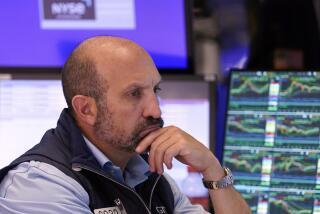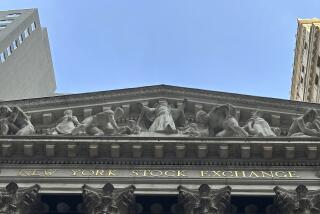Too big to fail? We’ll see about that
The mess in the U.S. financial system is making me nostalgic for the dot-com collapse of 2000-2002.
That, too, was a cataclysmic bursting of an insane market bubble.
But, as we are painfully learning, it’s one thing for the economy to lose Pets.com and a few hundred, or thousand, similar start-ups; it’s another thing entirely to watch the market bet on the demise of, say, the nation’s two largest providers of mortgage money.
The U.S. credit crunch turned 1 year old this month, and the situation clearly isn’t improving. Major financial companies continue to reel from huge losses on defaulted home loans. Barring a dramatic turnaround in the economy, commercial real estate loans could become the next black hole -- although the banks will say, as they did initially with home loans, that commercial losses should be “manageable.”
The unwinding of any market mania takes time, of course, and produces many casualties. That’s the ugly side of capitalism at work.
But the casualties of the tech bubble mostly were little companies that weren’t important in the greater economic scheme of things. Titans like Cisco Systems Inc. saw their stock market values plummet from 2000 to 2002, but there was never a danger that Cisco would go kaput.
By contrast, the enduring memory of the financial bubble’s collapse will be the number of marquee companies either swept away or forced to shrink drastically to survive.
That issue was a key element of a speech that Federal Reserve Chairman Ben S. Bernanke delivered Friday. The central bank chief focused on how regulators might deal with “future systemic shocks” within the financial industry -- company failures or near-failures so large they could trigger chain reactions with potentially dire consequences.
We’ve already lived through several such systemic shocks this year. Countrywide Financial Corp., brokerage Bear Stearns Cos. and IndyMac Bancorp are history, the first two rescued just in the nick of time by larger rivals, the third seized by the government.
Now, shares of mortgage titans Fannie Mae and Freddie Mac trade for less than a fast-food lunch as the market bets that a government takeover is inevitable, if not imminent.
This week was another rumor-fueled ride on Wall Street. Fears of an impending failure of another major financial company were stoked by a speech early in the week by Kenneth Rogoff, a former chief economist at the International Monetary Fund and a historian of financial crises.
“The worst is yet to come,” he said of the U.S. financial system. “We’re not just going to see mid-sized banks go under in the next few months. We’re going to see a whopper, we’re going to see a big one, one of the big investment banks or big banks.”
By late in the week Lehman Bros. Holdings Inc., long on the list of the most at-risk institutions, was said to be shopping itself to potential foreign buyers, including a state-run South Korean development bank.
And shares of Washington Mutual Inc., the biggest U.S. thrift institution, on Friday fell to their lowest level since mid-July on renewed jitters about the Seattle-based company’s viability.
U.S. regulators are in a trap. They’d prefer to simply allow ruined banks and other financial companies to fail, thus purging the system.
But the list of potential victims now includes too many of the biggest institutions, which in turn have financial ties to countless other players in the business. Every huge tree that falls can take down a lot of other trees.
Even so, Bernanke said Friday that regulators would have to be more disciplined in how they handle future shocks, with the goal of “reducing the range of circumstances” in which a threat to the financial system’s stability “might be expected by markets to prompt government intervention” -- i.e., a bailout.
For Fannie Mae and Freddie Mac, a bailout of some magnitude already is baked in the cake, thanks to the authority Congress gave Treasury Secretary Henry M. Paulson Jr. last month. “Too big to fail” is synonymous with Fannie and Freddie, given that they own or guarantee nearly half of all U.S. home loans.
But if regulators are ready to play tougher with other financial companies in jeopardy, they are likely to have plenty of opportunities to demonstrate their resolve.
That’s because the banking and brokerage businesses have entered a second phase of the bad-asset workout, according to one large hedge fund manager whose views circulate on Wall Street but who doesn’t seek or want publicity.
The first phase, the manager says, involved attempts by loss-ridden financial companies to raise fresh capital from investors. Some were successful, some were not.
The second phase, now underway, involves fire sales of assets by banks and brokerages that have no choice but to shrink themselves because there isn’t enough willing and able capital out there to buttress every damaged balance sheet that needs it.
And as assets are dumped at fire-sale prices, that will trigger markdowns of similar assets, further weakening the finances of banks and brokerages across the board.
“We are approaching a solvency crisis that we think is about to result in an avalanche of asset sales,” the hedge fund manager says.
Good luck, Chairman Bernanke.
--
More to Read
Inside the business of entertainment
The Wide Shot brings you news, analysis and insights on everything from streaming wars to production — and what it all means for the future.
You may occasionally receive promotional content from the Los Angeles Times.










